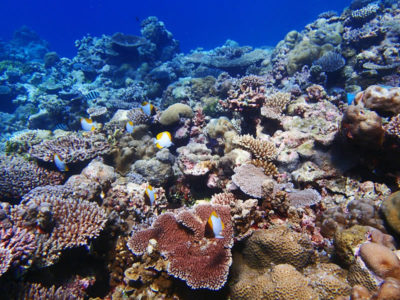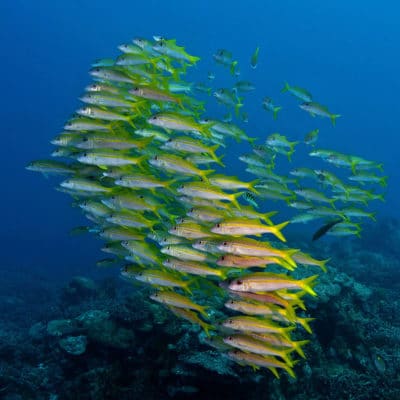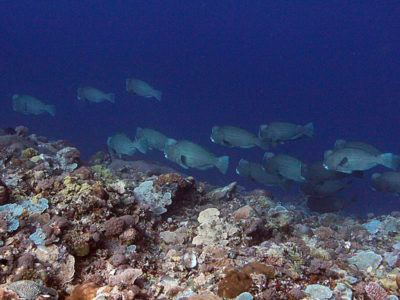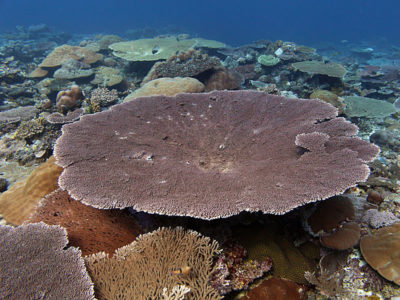Expedition Log: Palau – Day 21
Today is the last day the Global Reef Expedition’s mission to Palau. Over the last five weeks our team of scientists surveyed 85 different coral reefs, stretching from Angaur in the south, through the majestic reefs of the Rock Islands UNESCO World Heritage Site, all the way to Kayangel Atoll and Ngeruangel Reef in the north. We explored barrier reefs, atolls, fringing reefs, reef channels, back reef environments and lagoonal patch reefs assessing the community dynamics and health of corals, fish and other benthic organisms.

A vibrant, shallow-water coral reef in southern Palau.
When looking back, what is most apparent is the diversity – no two reefs were the same. The dominant coral species, the reef structure, fish communities and condition varied between habitats and even within reefs that were fairly close to each other. Some coral reefs had unusually high amounts of living coral made up of very old single species assemblages. Many of the outer reefs that nearly died in the devastating 1998 bleaching event had come back – now dense thickets of branching staghorn corals, needle corals, table acroporids and many other species covered the bottom. Other sites (especially on the east and in the north) had virtually no living coral: the bottom was a scoured pavement with large boulders (coral skeletons) that had been detached and tumbled down the reef slope, piles of rubble and mats of cyanobacteria. This was the aftermath of two of the most powerful typhoons to hit Palau in recent memory. But even in these sites there were signs of new life. Fragments of the pulverized coral were still alive, having reattached to the bottom and beginning to regrow. Coral larvae had settled, attached and formed small colonies. And the substrate was free of fleshy seaweed (macroalgae), having a bright pink layer of crustose coralline algae. All signs of the unusually high resilience of Palau’s coral reefs.
Two years after the storm, several species of corals such as Pocillopora, Stylophora and Acropora have reached sizes of 3-5 cm and a fewe smaller massive corals are present.
The reef fish community was as diverse as the corals. We recorded over 530 species of fish. Assemblages were distinctly unique between sites located inside lagoons and those at the fore reef. Sharks, jacks, barracuda and snappers were the dominant predators at most fore reef sites, while groupers were more common in lagoonal reefs and they also formed large aggregations in the reef channels. Within lagoonal sites fish were relatively more abundant at the shallow areas up to about 8m depth where live hard corals dominate and physical complexity was more obvious. At depths below 10m there was relatively less structure and live hard coral, and fish are noticeably less abundant. At fore reef sites, target species such as snappers and groupers occurred in patches, usually at depths below 12 meters. The shallow fore reef communities had an abundance of herbivores such as surgeonfish and parrotfish that help keep the reef free of macroalgae.
Abundant Schools of Fish Around Palau’s Coral Reefs
Bigeye Jacks (Caranx sexfasciatus) / Yellowfin Goatfish (Mulloidichthys vanicolensis)




Yellowtail Barracuda (Barracuda obtusata) / Bumphead Parrotfish (Bulbometopon muricatum)
There were a few alarming trends, though. On the western barrier reef in the north, there was an extensive outbreak of a coral disease called white syndrome. This disease was killing some of the largest colonies of table acroporids. It had passed through some reefs, killing most of the table corals. All that was left were graveyards of skeletons, denuded of tissue but still in growth position. These were often covered in hairy fronds of red cyanobacteria. Further south, at the center of the outbreak, we found hundreds of diseased colonies, most partially dead with a prominent white band of recently killed tissue. The ramifications of this are not yet known. However, even in the hardest hit area some corals of these species had survived and many smaller colonies of the same species were becoming reestablished. The skeletons provided an excellent place for the settlement of new corals.
The western barrier reef also had some very unusual temperature fluctuations. In some cases there was a dramatic thermocline below 15-20 m. Water temperatures dropped from 28 ⁰C to 23-24 ⁰C. This is the same thing that happened early in 2010 during the tail end of an el Nino event. Very rapidly, it flipped to a La Nina which brought on coral bleaching in the summer of 2010. What’s unusual is that coral bleaching in Palau is associated with La Nina’s, when the cool water we saw disappears and temperatures can climb upwards of 30⁰C to depths that exceed 90 m. This same trend was seen in 1998. In both cases, there was extensive bleaching and mortality.

Healthy table Acropora hard corals along an outer reef site.
With any luck Palau will escape a bleaching event and conditions return to normal. There have been a number of other large scale disturbances affecting Palau’s reefs in the recent past, but what we saw is a remarkable resilience. Given Palau’s small population, limited human development and extensive conservation initiatives, these precious places in Palau will continue to flourish.
Photos: 1 Andersen Mayfield; 2,7 Andrew Bruckner; 3-4 Ken Marks; 5-6,8 Grace Frank

